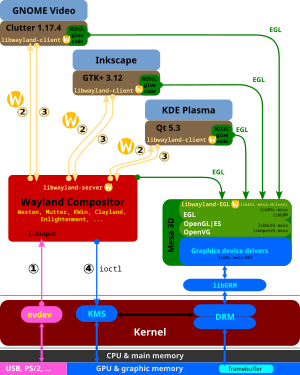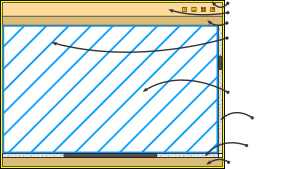Windowing system
A windowing system (or window system) is a type of graphical user interface (GUI) which implements the WIMP (windows, icons, menus, pointer)paradigm for a user interface. Each currently running application is assigned a usually resizeable and usually rectangular shaped surface of the entire screen to present its graphical user interface to the user. Usually a window decoration is drawn around each window. The programming of both, the window decoration and of available widgets inside of the window, these are graphical elements for direct user interaction, such as sliders, buttons, etc., is eased and simplified through the use of widget toolkits. The idea behind any of the available desktop environments is to use the same widget toolkit for all clients, and to create and groom icon sets and themes to achieve a consistent "look and feel" for at least the main programs, such as the file browser.[citation needed]
- Most popular windowing systems are X11 and Wayland.[citation needed]
- Most popular widget toolkits are GTK+/Clutter and Qt.[citation needed]
- Most popular desktop environments are GNOME and the KDE Software Compilation.[citation needed]
Contents
[hide]Technical details[edit]
The main central key component of any windowing system is usually called display server, though alternative denominations such as window server or compositor are also in use. Any application that runs and presents its GUI in a window, is a client of the display server. The display server and its clients communicate with each other over a communications protocol, which is usually called display server protocol, the display server being the mediator between the clients and the user. It receives all the input from the kernel, that the kernel receives from all attached input devices, such as keyboard, pointing devices, or touchscreen and transmits it to the correct client. The display server is also responsible for the output of the clients to the computer monitor. The output of sound is usually not managed by the display server, but the sound volume, is usually handled through GUI applets and it is the display server who decides which applications are on top. A windowing system enables the computer user to work with several programs at the same time. Each program presents its GUI in its own window, which is generally a rectangular area of the screen.[citation needed]
From a programmer's point of view, a windowing system implements graphical primitives such as rendering fonts or drawing a line on the screen, effectively providing an abstraction of the graphics hardware from higher level elements of the graphical interface like window managers.[citation needed]
A display server protocol can be network capable or even network transparent, facilitating the implementation of thin clients.[citation needed]
List of windowing systems[edit]
For Unix-like operating systems[edit]
- 8½ and rio for Plan 9
- FramebufferUI (fbui) in-kernel windowing system
- HP Windows
- ManaGeR (MGR)
- Metisse
- Mir
- NeWS / OpenWindows
- NeXT DPS
- Qt Extended
- Quartz Compositor (Mac OS X)
- SunView
- Twin (Text WINdows)
- W Window System
- X Window System
- Wayland
- Xynth
- XFast
Web windowing systems[edit]
- Dojo
- ExtJS
- TIBCO General Interface
- Web Window Manager
Other[edit]
Operating systems such as Microsoft Windows, Mac OS (version 9 and earlier), and Palm OS, contain a windowing system which is integrated with the OS.[citation needed]
See also[edit]
출처 - http://en.wikipedia.org/wiki/Windowing_system

